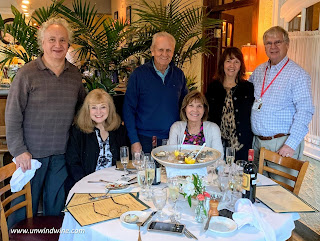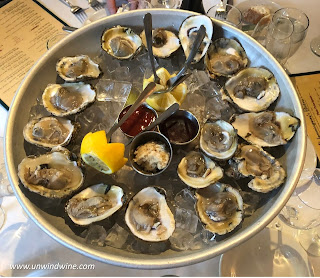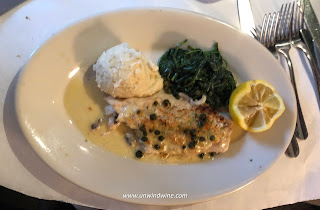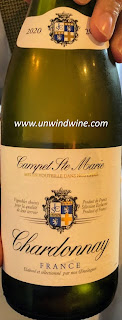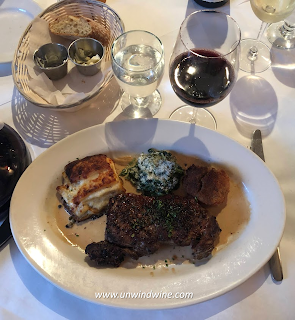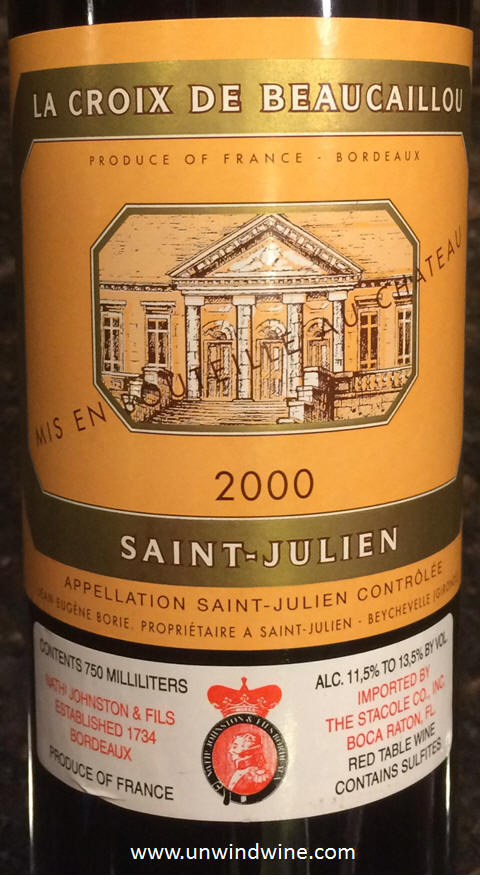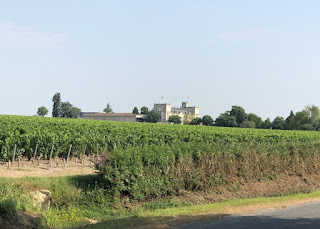Croix de Beaucaillou, Ducru #2 BYOB at Suzette's Creperie
Thursday night out, we dined at Suzette's Creperie, our favorite suburban French Bistros, in Wheaton (IL). Unfortunately, it was an off-night for Suzette's. Perhaps they were overwhelmed, or distracted by their hosting a wine tasting dinner in the main dining room.
In any event, they were not able to serve either of our first entree choices, our usual favorite, the Sole Meunière, or the filet of beef. As a result, we both had to resort to an alternative choice on what is already a somewhat restricted, limited menu.
I ordered my usual favorite starter, the Pate' plate, followed by their Three Cheese Souffle. The souffle was delicious. Three Cheese Soufflé - Goat, Blue and Gruyere Cheese flavor this glorious bubbly Soufflé.
Linda opted for the Pork Tenderloin, not her favorite, and she was disappointed in the lackluster dish that was more mundane than it looked, or sounded - Pork Tenderloin with Sautéed Apples in a Brandy Crème Sauce, served with Mashed Potatoes and Seasonal Vegetables. As the daughter of a beef cattleman farmer, its anathema for her to indulge in pork.
The highlight of the evening, besides my souffle, was our wine selection, from our home cellar, BYOB, the Ducru St Julien Bordeaux wine.
Croix de Beaucaillou St Julien Bordeaux 2009
At a decade, plus, the 10-12 year mark seems to be is just about perfect for such a great second wine in an exceptional vintage. The grand vin is the result of an increasingly strict selection process, with approximately 50% of the production going into the final wine, and the balance used in the Croix de Beaucaillou. Robert Parker's Wine Advocate stated, 'The 2009 may be the finest example of this cuvee I have yet tasted.'
We actually first discovered this label during our visit and tour to Château Ducru Beaucaillou in St Julien Bordeaux.
Ducru Beaucaillou produces two wines. The flagship grand vin Château Ducru-Beaucaillou, and this Croix de Beaucaillou, a second wine, first introduced in 1995. This allows the finest lots to be dedicated to the grand vin, with lesser-quality lots relegated to the second label. This practice of having two tiered labels in the brand is customary with all the notable producers in the Medoc including the super premium first growths, and the 'super seconds', such as Ducru.
All the Ducru wines are aged for 18 months in 50% to 80% new oak barrels, depending on the richness of the vintage. The batches are racked every three months to remove sediment and to top off the barrel filling in the void of evaporation. We watched them rack the barrels during our visit, which allowed us the opportunity to taste the 2018 vintage, from the barrel.
These regular toppings-up are carried out during the first six months of ageing. The wines are racked from the bottom of the barrels every three months for a total of seven rackings during the ageing period. They are then fined with egg whites, lightly filtered, and then bottled. Bottling takes place in a sterile atmosphere under inert gas.
This release of this label was awarded 94 points by Decanter, 93 points by James Suckling and Wine Enthusiast, and 91 by Wine Advocate and Wine Spectator.Last time we tasted this back in 2021 I noted a bit of green pepper that I noted as off-setting. when I wrote, "Dense dark garnet purple colored, medium full bodied, rich concentrated
textured black berry and black cherry fruits, notes of creme de cassis,
exotic spices, tobacco leaf, black tea, black truffle and hints of green
pepper, wood, smoke and earth that tend to be offsetting a bit on the
finish, detracting from the overall experience."
Jancis Robinson noted a similar experience, "Maybe a very slight bitterness on the finish, hence the minus."
This
diminution from the funky layer was less so the second day and perhaps
could've been avoided with decanting and aeration some time before
tasting. I purchased a six pack so we will have more opportunities to
determine the optimal tasting approach and whether this was simply a
bottle variation from that first bottle.
https://unwindwine.blogspot.com/2021/08/croix-de-beaucaillou-2009-i-picked-up.html
This night there were no indications of this funkiness. Hence I awarded this a higher rating, from 89 previously, to 91 points.
Dark garnet colored with slight purple hues, medium-full bodied, s 'smaller', less complex and slightly more modest version of the grand vin (albeit at a fraction of the price, so as to be a great value - hi QPR), still elegant and smooth with polished blackberry and black cherry fruits, textured with notes of creme de cassis and black tea with hints of smoke, earth, spice, hint of truffle, with firm tannins and a bit of mineral on a chewy finish.
RM 91
https://www.cellartracker.com/wine.asp?iWine=3004572







